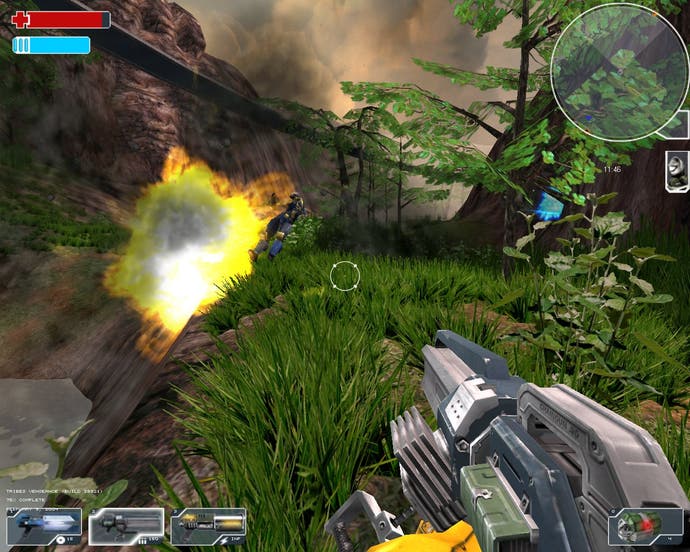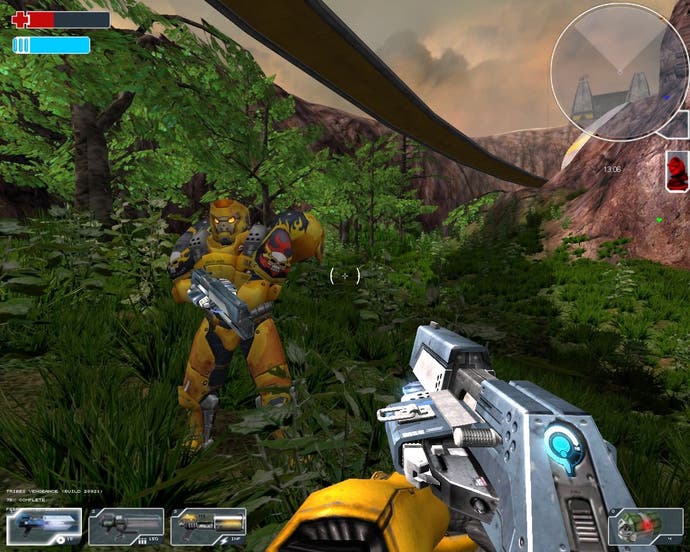Tribes: Vengeance
We spend some time with the multiplayer side of Irrational Games' Tribes title, and reckon it's probably best to get your skis on.
As you may remember, a couple of months ago we dropped in to Vivendi's Paris headquarters to have a look at Tribes: Vengeance. We certainly remember; it's not every day you encounter a hotel pianist who's willing to tackle a Nick Cave and Kylie duet on his own and then segue into Enter The Sandman afterwards, whilst throwing worryingly flirtatious glances across the room from behind his stubble and tossing his hair around like a model. But anyway, one of the most interesting things about that trip came about before we'd even set foot on the Eurostar; it came when your dutiful correspondent asked a few of his first-person shooter loving friends if they had any questions they'd want the game's producer to answer while we were there.
Where The Wild Skis Grow

Now, before we get into that, it's worth pointing out for anybody who hasn't played it before that Tribes is unlike most first-person shooters. You're using W, S, A and D to move and strafe, pointing your gun with the mouse and firing with the left button, of course, but the right button is bound to a jetpack, which sends you flying into the air and has just enough juice in it to keep you up there for a decent while, but doesn't recharge quickly enough to stop you having to come down again from time to time.
The maps are huge, largely outdoors and very hilly and often built-up affairs, and the two bases in Capture the Flag mode (or objectives in the other game modes, of which more later) are strewn far and wide. As such, making use of the jetpack to get around is arguably the only way to get anywhere without dying of boredom or being shot to pieces by your adversaries overhead. There are vehicles, there are defences to deploy and watch over, there are inventory stations that allow you to retool with different weapons and character classes (light, medium or heavy), and that's only the start.
But back to our anecdote: Unsurprisingly, given the sort of company this writer keeps, our aforementioned FPS loving chums certainly did have a few questions. Almost immediately after asking, an email popped up in our inbox more or less as follows: "One of the first things that got people into Tribes, and kept them there," it declared, "was its amazing outdoor physics, and the fact that you could fly at hundreds of miles per hour with a bit of practice. Has it been possible to keep this same feel using the Unreal engine?" Which was a fair question, we thought. The speed and mobility of Tribes was always going to be a tough thing for a new developer to get right - Irrational Games having taken the lead on Tribes: Vengeance after the unfortunate demise of series creators Dynamix.
Then, a couple of minutes later, another rather less Tribes-loving individual popped up with an alternative: "One of the really awful things that put people off Tribes, and kept them away, was its utterly ridiculous outdoor physics, and the fact that you could have some [moron] fly into your base at hundreds of miles per hour and grab the flag despite any organised defence in place. Has it been possible to kill this stupid [clucking] exploit without bending over and pandering to the tiny entrenched and whinging 'community' of players?"
Beta Than Before

Tribes, then, had this habit of polarising opinion. On the one hand, some people loved skiing - originally a physics exploit, an offshoot of the game's popular rechargeable jetpack - which gave the player zero friction for a short space of time whenever he ran out of jetpack juice and hit the ground, and with a bit of underhanded coding or quick-fingered control could be manipulated to propel him along at astonishing speed. It arguably proved to be the lynchpin of the entire multiplayer experience after a while. On the other hand, most newcomers - even FPS veterans - had difficult getting to grips with it, felt it upset the balance, or thought it was just plain cheating. Dealing with skiing was always going to be a thorny issue for Irrational Games.
Tackling the ongoing Tribes: Vengeance beta, though, it seems that the developer has settled on a balance that, while it will won't keep absolutely everybody happy, will please more of the people more of the time, without alienating fans of the original. In short, skiing is now a feature, and making use of it is integral to the experience - arguably more beneficial than mastering the jetpack.
The game can of course be played in much the same way as any normal game of Capture The Flag, and the inclusion of vehicles - and arguably a sharper, neater set than in previous Tribes titles - helps here a lot. With 12 players a side, you can send quite a convoy off to try and capture the opposing flag. Fighters in the air, which resemble floating Atlaspheres from Gladiators, are controlled in much the same way as the player (WSAD/mouse for movement, right-click for upward propulsion, space bar to descend), and their guns pack a mean wallop, while Assault Ships are more brutish to handle but do more damage.
On the ground, Jump Tanks (which do actually hop when you right-click) are powerful and resilient, while Rover jeeps are fast and manoeuvrable. And of course the default foot soldiers can zoom around with their jetpacks as opposing forces try and take each other down while avoiding their spinfusor weapons' punishing splash damage when they have no choice but to land.
Jump Around

But if you can master skiing then you could pinch the enemy flag and have it back before the impending armada has even had a chance to set off down the winding roads to the enemy base. By holding the space bar as you move, you give up all semblance of friction and slide along (or 'ski', obviously), and coupled with a decent burst of jet propulsion and the naturally curvy architecture of the rolling hills that make up much of the scenery, with a bit of practice you can slide down a hill at fearsome speed and then rocket up off the nearest incline, thunder through the enemy base and be gone with the flag in an instant.
At which point the pursuit becomes the interesting aspect - will hovering Fighters manage to smash you out of the air or time their shots to catch you as you hop across the landscape? Or will you manage to avoid their attentions long enough to make it back to the relative comfort of home and bank the flag, assuming some wily skier on the other side hasn't done the same to you in the meantime?
The clever thing about Tribes: Vengeance though is that even as the heroics of practiced skiers dominate the flag-swapping, less able or less interested team-mates can take on other roles - repairing damaged inventory stations, deploying resupply stations and sensors and healing wounded team-mates in the field; piloting vehicles and backing up the smash-and-grab on the other side of the map; manning stationary turrets and hauling their Quake 2 Tank-like 'heavy' exoskeletons into defensive positions; sniping; or playing one of a number of other roles carved out of the clever but logical mix of vehicles, classes and packs that Irrational has settled upon.
Lesson Learnt?

Previous Tribes games had this sort of balance and structure, but things were a bit less coherent. Now there are just a few classes, packs and weapons to choose from, and experimentation and functionality is a bit more logical. Each 'pack', for example, has a passive and an active function, the latter activated by the Q key by default. Repair packs will passively recharge, and actively heal others. And there have been some sensible balancing judgements made, like an ammunition limit on the deadly laser rifle, so you can't just camp down somewhere and pick off enemies endlessly - and if you do try it, you'll have to contend with either resupplying back at base regularly or defending your own self-deployed resupply station, which is nowhere near as simple.
It all makes for an engaging and much more accessible experience than before, even though it lovingly retains and embellishes many of the things that made the first games so popular. The physics are more or less in line with what veterans will expect, the map design has been tightened up so players spend less time traversing vast distances, which adds a level of immediacy sometimes absent from the originals, and the design of the maps themselves is balanced and intelligent enough without being outright symmetrical or formulaic in two many cases.
There are various play modes too. We've spent most of our time with Capture The Flag so far, but you'll also be able to tackle Arena ("'you lose and you're out' team deathmatch," in the words of the producer), Ball (which is as it sounds), Rabbit (where you have to try and keep the opponent's flag out of their hands), and Fuel (which involves controlling supplies of fuel located in depots strewn around the map). What's more, the Tribes level editor - which will ship with the game - will allow map designers to mix and match these styles in the same game, and the maps we've played so far also feature a number of capture-and-hold style control points that give teams another option when it comes to picking a respawn location from the overhead, Battlefield 1942-style map after death.
Vengeful? Nah.
As a multiplayer game, it's more coherent and immediate than we remember Tribes ever being, and Irrational hasn't been afraid to drag it up to modern standards in graphical terms either, giving the whole thing a much sharper look with better weapon and character models (we still adore the mid-air death animation, too, where the player flips and spins limply in the air as the jetpack continues to kick out energy) and gorgeous landscapes with vast draw distances and lots of throwaway but thankfully toggle-able detail like individual blades of grass and shiny and reflective metal surfaces. Performance on this writer's PC (a P4 2.8GHz, 1GB RAM, Radeon 9700 Pro) was solid at 1280x1024, and Irrational reckons the game will run happily enough on an entry-level 1GHz PC, although a big chunk of memory wouldn't go amiss.
On top of all that, there's the prospect of a perhaps surprisingly strong narrative-driven single-player adventure, which tackles most of the skills you'll need to advance online and wraps the whole thing neatly up in its own little mythology. We've all heard about 'arena' FPS games with single-player modes before, of course, but this seems to be something different - as we noted in our impressions when we returned from Paris in July. Perhaps then the overall game won't help our two warring comrades overcome their conflicting views of skiing, but we reckon there's a good chance we'll be enjoying ourselves rather too much to care.
Tribes: Vengeance is due out on PC later this year. You can sign up and participate in the Tribes: Vengeance multiplayer beta by heading here.

